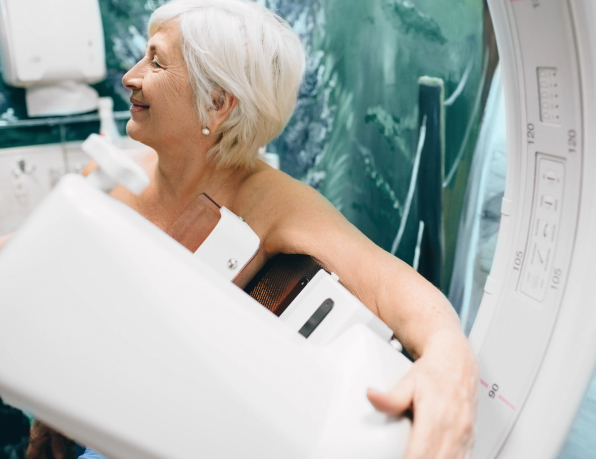Women’s Imaging

Overview
St. Luke’s tailors breast screening based on individual risk factors. A combination of carefully chosen screening exams may lead to a significant increase in early cancer detection while decreasing the amount of unnecessary return visits and biopsies.
An annual screening mammogram is the best way to find breast cancer early, when it is easier to treat and before it is causing symptoms. When you come in to a St. Luke’s Women’s Imaging Center for a routine screening (a screening mammogram), you will be greeted by our friendly, professional staff in a comfortable and private environment. Our dedicated breast specialists will interview you in order to perform a comprehensive breast cancer risk analysis tailored specifically to your personal risk factors.
Should you require a diagnostic exam, it means that an area of the breast requires further examination or you may be experiencing a new breast problem. A diagnostic exam may include a mammogram, ultrasound or a biopsy, as well as any other testing that may be appropriate. Should the diagnostic exam identify a problem, you will have the opportunity to speak with the breast health nurse navigator to ask questions about your diagnostic exam. Your referring physician will be notified immediately with the results.
Your breast health nurse navigator will provide you with ongoing support through education and routine follow-up calls.
This non-invasive exam is used to gain information about breast abnormalities detected with mammography, physical exam, or other breast imaging. MRI also may be used for breast implant evaluation, staging breast cancer, evaluating treatment options, and follow-up after treatment is complete. MRI also may be an option for patients with dense breasts and with a strong family history of breast cancer. Please discuss with your physician if Breast MRI is appropriate for you.
This is a test that sends high-frequency sound waves into the breast. The pattern from the sound waves is converted into an image of the interior of the breast to help distinguish between tumors which are solid and cysts which are filled with fluid.
St. Luke's uses the genetic profile of an individual's breast cancer to help determine if chemotherapy should be given as an adjuvant therapy.
SenoClaire® low-dose 3D mammography from GE delivers the quality of a 3D image while limiting the X-ray dose to an amount equivalent a 2D mammogram. The 3D technology uses a low-dose, short X-ray sweep around the compressed breast. This imaging technique is designed to separate the tissues and to reduce the overlapping of structures.
This is a technique used prior to surgery to locate and mark a mammographic area of concern in the breast that cannot be felt. Such areas include masses and microcalcifications.
GE’s SensorySuite® simulates a soothing environment to reduce the worry experienced by some women during mammography by stimulating a woman’s sense of sight, sound and aroma simultaneously. A woman may choose the environmental ambiance she prefers – seaside, garden or waterfall for her 2D or 3D mammogram.
Under ultrasound guidance, a breast abnormality is located and, using a specially guided needle, small samples of tissue are removed under local anesthesia and sent to the laboratory for evaluation.
This is an examination using an ultrasound-guided needle to remove fluid from a cyst.
A Personal Plan of Care
For the early detection of breast cancer, St. Luke’s and the American Cancer Society recommend the following guidelines:
Clinical breast exam
A clinical or physical exam should be performed by your doctor as part of your regular annual check-up. This should include a visual exam of your breasts, looking for changes in the skin, size and shape of the breast. The physician also should feel or palpate your breasts, checking for lumps. Discuss with your physician how often you should have a clinical exam.
Breast awareness & breast self examination
Your breasts will undergo changes throughout your lifetime. It is important to learn what is normal for you and report any changes to your doctor right away. Adult women of all ages are encouraged to perform breast self-exams. By performing breast self-examination during the same timeframe every month, you will become very familiar with your breasts and can recognize a change if one occurs and talk to your physician about any changes you experience.
As an international show site for GE Healthcare, St. Luke’s University Health Network offers state-of-the-art breast imaging technologies at Women’s Imaging Centers throughout its network in Pennsylvania and New Jersey.
St. Luke’s Individualized Breast Screening Program
If you’re 40 or older, yearly screening mammograms are an essential part of your health care. However, some women may benefit from additional breast screening to supplement mammography.
St. Luke’s tailors breast screening based on individual risk factors, to develop an individualized screening program, resulting in earlier detection of breast cancer. A combination of carefully chosen screening exams may lead to a significant increase in early cancer detection while decreasing the amount of unnecessary return visits and biopsies.
The St. Luke's Breast Care Team
Our radiologists, technologists, nurses are highly skilled professionals with advanced certifications in breast imaging and breast health navigation. Your mammogram will be interpreted by a board-certified radiologist who also serves as a consultant to your personal physician. Should further treatment be necessary, our breast health nurse navigators will reach out to you to schedule to appropriate diagnostic imaging tests.


